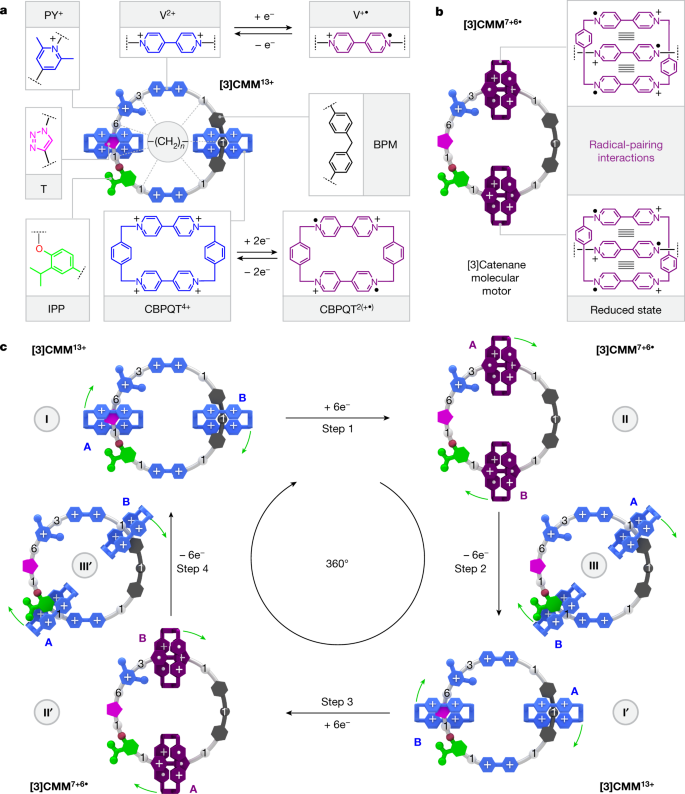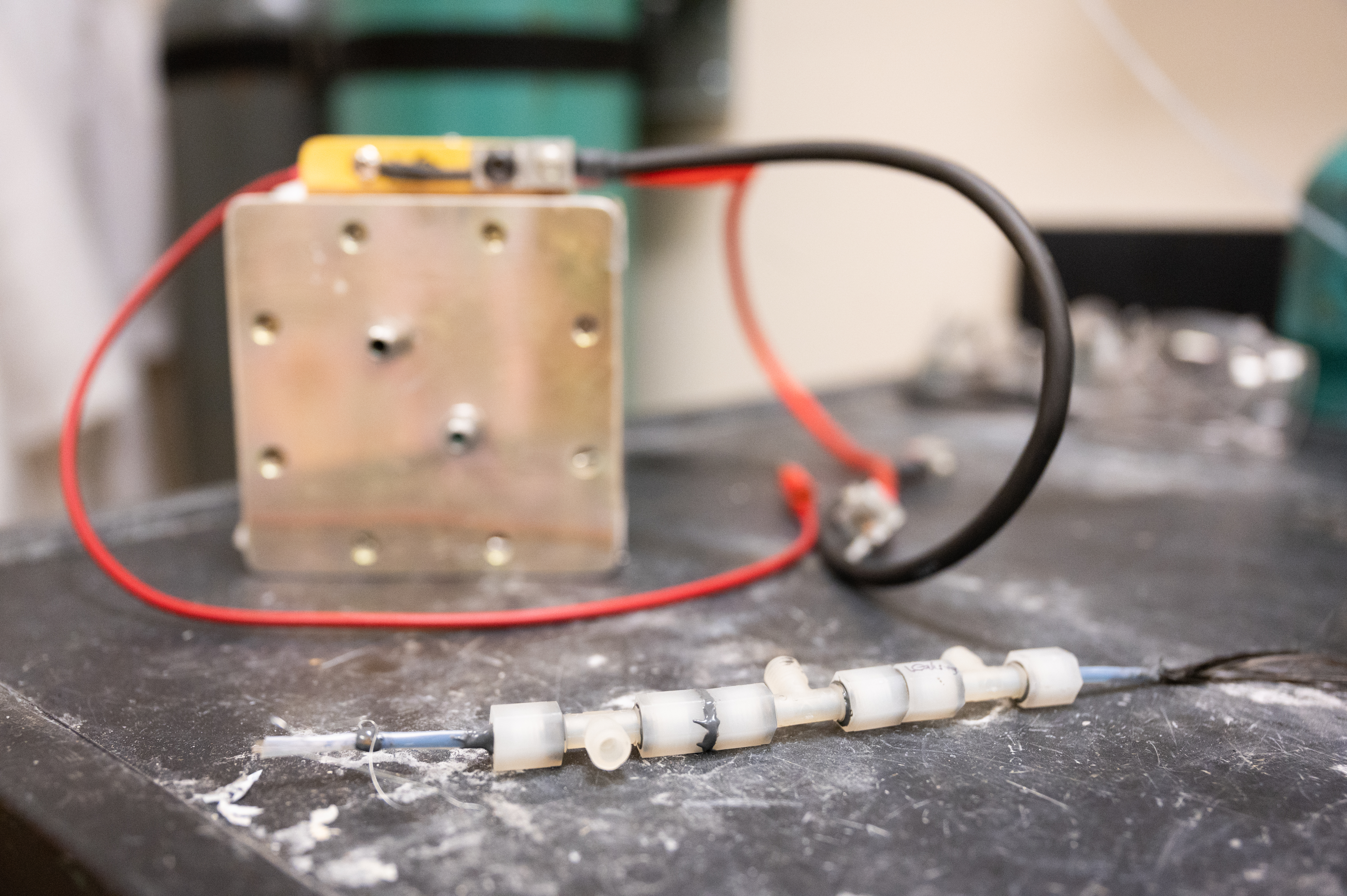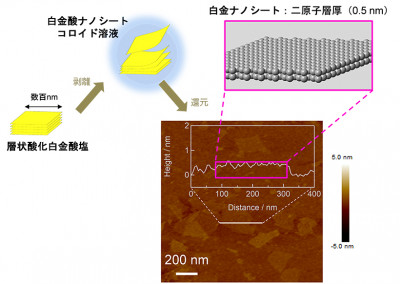小さなモーターが、材料科学や医療の革新をもたらす日がやってくる Tiny motor one day could drive innovations in materials science and medicine
2023-01-11 ノースウェスタン大学
Weinberg College of Arts and SciencesのBoard of Trustees Professor of ChemistryであるStoddartは、この研究の共同執筆者である。この研究は、分子機械の理論家でありメイン大学教授であるDean Astumian氏と、計算化学者でありカリフォルニア工科大学教授であるWilliam Goddard氏と緊密に協力して行われた。Stoddart教授の研究室の博士研究員であるLong Zhangは、この論文の筆頭著者であり、共同執筆者でもあります。
この分子モーターは幅がわずか2ナノメートルで、大量に生産されたのは初めてです。このモーターは簡単に作ることができ、素早く作動し、廃棄物も発生しません。この研究結果は、1月11日『Nature』誌に掲載されました。
研究チームは、カテナンと呼ばれる環が強力な機械的結合でつなぎ合わされたある種の分子に着目し、その構成要素がバラバラにならずに自由に相対移動できることを明らかにした。
この電動分子モーターは、カテナンの構成要素である2つの同じ環が連動したループが酸化還元活性を持つ、つまり電位の変化に反応して一方向に運動するものをベースにしている。研究者らは、この一方向の動きを実現するためには、2つのリングが必要であることを発見した。実験では、1つの環に1つのループが連動しているカテナンは、モーターとして動かないことがわかった。
外部エネルギーを方向性のある運動に変換するというモーターの機能を果たす分子の合成と動作は、化学、物理学、分子ナノテクノロジー分野の科学者にとって、かねてからの課題であった。
Stoddart教授、Zhang教授とノースウェスタン大学の研究チームは、この画期的な成果を達成するために、電気分子モーターの設計と合成に4年以上を費やした。この間、米国メーン大学のアストゥミアン教授とカリフォルニア工科大学のゴダード教授と共同で、モーターの動作メカニズムを説明するための量子力学計算を完成させた。
「分子スケールで構成要素の相対的な動きを制御することは、非常に困難な課題であるため、共同作業は非常に重要でした。「合成、測定、計算化学、理論の専門家と協力することで、溶液中で動作する電気分子モーターを開発することができました。
単一分子電気モーターの例はいくつか報告されていますが、超高真空を使うなど過酷な動作条件を必要とし、廃棄物も発生します。
研究者らは、彼らの電気分子モーターの次のステップとして、電極表面に多数のモーターを付着させて表面に影響を与え、最終的に何らかの有用な働きをさせることを挙げている。
<関連情報>
- https://news.northwestern.edu/stories/2023/01/now-on-the-molecular-scale-electric-motors/
- https://www.nature.com/articles/s41586-022-05421-6
電動分子モーター An electric molecular motor
Long Zhang,Yunyan Qiu,Wei-Guang Liu,Hongliang Chen,Dengke Shen,Bo Song,Kang Cai,Huang Wu,Yang Jiao,Yuanning Feng,James S. W. Seale,Cristian Pezzato,Jia Tian,Yu Tan,Xiao-Yang Chen,Qing-Hui Guo,Charlotte L. Stern,Douglas Philp,R. Dean Astumian,William A. Goddard III & J. Fraser Stoddart
Nature Published:11 January 2023
DOI:https://doi.org/10.1038/s41586-022-05421-6

Abstract
Macroscopic electric motors continue to have a large impact on almost every aspect of modern society. Consequently, the effort towards developing molecular motors1,2,3 that can be driven by electricity could not be more timely. Here we describe an electric molecular motor based on a [3]catenane4,5, in which two cyclobis(paraquat-p-phenylene)6 (CBPQT4+) rings are powered by electricity in solution to circumrotate unidirectionally around a 50-membered loop. The constitution of the loop ensures that both rings undergo highly (85%) unidirectional movement under the guidance of a flashing energy ratchet7,8, whereas the interactions between the two rings give rise to a two-dimensional potential energy surface (PES) similar to that shown by FOF1 ATP synthase9. The unidirectionality is powered by an oscillating10 voltage11,12 or external modulation of the redox potential13. Initially, we focused our attention on the homologous [2]catenane, only to find that the kinetic asymmetry was insufficient to support unidirectional movement of the sole ring. Accordingly, we incorporated a second CBPQT4+ ring to provide further symmetry breaking by interactions between the two mobile rings. This demonstration of electrically driven continual circumrotatory motion of two rings around a loop in a [3]catenane is free from the production of waste products and represents an important step towards surface-bound14 electric molecular motors.



